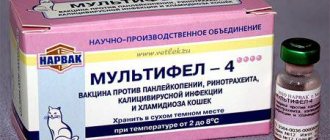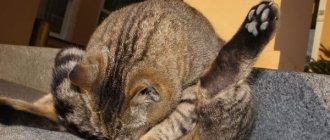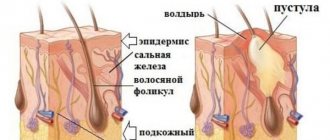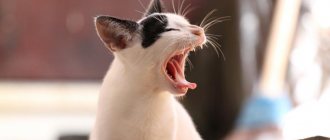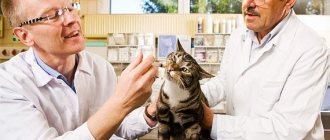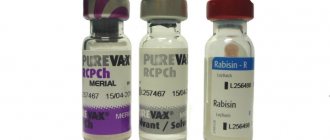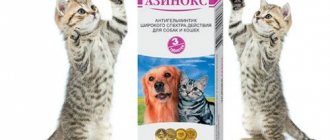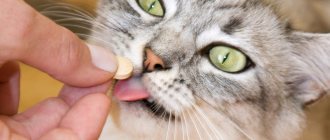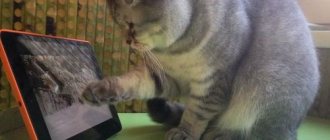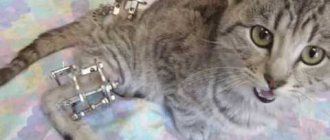When a pet is sick, the owner must be attentive, monitor possible deviations in behavior and provide the necessary assistance, because the pet itself does not have the opportunity to report poor health.
The mammalian body is designed in such a way that it cannot create oxygen reserves. In view of this, heavy breathing in a cat or any other breathing disorder can lead to serious and sometimes irreversible consequences.
Symptoms of breathing disorder:
- an unusual position in which the animal is located for quite a long time;
- difficulty exhaling or inhaling;
- inability to lie down;
- unusual sounds made by the pet: wheezing, squeaking, sobbing;
- breathing with an open mouth;
- anxiety, nervousness;
- bluish coloring of lips and gums or their pallor.
Causes of Difficulty or Rapid Breathing in Cats
The characteristics of the respiratory process depend on internal and external factors. In some cases, increased breathing is justified by physiology and should not cause concern. However, it can also indicate pathology, so if other symptoms occur, you should consult a veterinarian.
Conditions that do not require veterinary intervention
A change in breathing frequency often occurs in a dream - this is how the emotions experienced during a dream are manifested. This phenomenon may be associated with the sexual cycle, pregnancy, surgery, nervous shock, physical activity, and environmental conditions. In these cases, veterinary assistance is usually not required.
Overheating of the animal
Overheating is a condition that results from prolonged exposure to high ambient temperatures. When overheating, the animal’s body activates internal resources - breathing becomes more frequent, due to which the tissues are more actively supplied with blood and heat transfer increases. In hot weather, the concentration of oxygen in the air is reduced, and frequent breathing helps maintain its level in the blood. The following signs indicate overheating: body temperature above 40 degrees (measured rectally), increased heart rate, redness of the mucous membranes. The animal breathes frequently and sticks out its tongue.
Physical exercise
Often after active games, the cat lies down on its side and breathes heavily. Difficulty breathing is due to the fact that during physical activity, muscles and internal organs consume more oxygen than usual. Accelerating respiratory contractions allows you to maintain the level of this gas necessary for the animal. If respiratory activity returns to normal within a few minutes of rest, rapid breathing after active games should not cause concern.
Stress (intense joy, fear, anxiety, etc.)
If a cat, cat or kitten is breathing heavily, a possible reason is a strong emotional experience. With high levels of stress, the concentration of cortisol and adrenaline in the blood increases, which causes increased blood pressure, increased respiration and heart rate. These changes are a protective mechanism that allows cats to survive in a difficult situation: nutrition of the brain and muscles improves, which leads to an increase in the speed of reaction and movement.
Basic information
Rapid breathing is caused by the following reasons:
Surgery, including sterilization. In this way (by increasing heart rate and breathing), the cat’s body tries to recover after the administration of medications. The frequency and depth of breaths may be disrupted, and then level off on their own. If the lips, gums and nose begin to turn blue, the cardiovascular or respiratory system is affected. The cat needs qualified veterinary care;
- Overheating of the animal, including after physical activity. Unlike humans, cats do not have sweat glands. Therefore, tachypnea occurs when the animal tries to cool down. At the same time, the cat sticks out its tongue and breathes briefly and frequently.
- Okot. Childbirth is a strong stress for the body, which can cause rapid breathing. After giving birth, your cat may not need help if her breathing returns to normal over time.
- Severe fright or stress can cause emotional distress in a cat. In addition to external signs (severe fear and pinned ears), hidden ones (pain) are also added. In addition, the animal can show aggression - attack or hide.
- Pathologies of internal organs, leading to an increase in the size of these organs, increased abdominal pressure, ascites, diseases of the heart, blood, lungs and endocrine disorders.
Physiological dyspnea
Shortness of breath is almost always a sign of oxygen starvation of the body, which arises for various reasons.
Physiological shortness of breath does not require treatment. It represents the body’s reaction to certain unfavorable factors or extreme conditions. After their action ceases, the cat's breathing gradually becomes calm.
Causes
Physiological shortness of breath is characteristic of:
- severe stress;
- chest injury;
- heavy physical activity;
- overheating of the body.
Stressful conditions
During stressful conditions, the hormone adrenaline is automatically released into the blood, which has the ability to stimulate cardiac activity. The body's need for oxygen increases sharply. To compensate for this deficiency, the cat actively breathes with its open mouth.
Chest injury
Shortness of breath during chest injury is a normal physiological response of the body to pain. If the chest is bruised or the ribs are broken, deep breathing becomes impossible, as it can cause pain to the cat. In such situations, rapid shallow breathing through the mouth is observed.
Great physical activity
During fast running, hunting and games, cardiac activity is stimulated. Active blood circulation automatically leads to accelerated burning of oxygen. The animal stimulates gas exchange in the lungs, increasing the number of breathing movements.
What kind of help does a veterinarian provide?
Before the examination, the veterinarian always collects an anamnesis - detailed information about what preceded the condition, what other symptoms there are and in what conditions the cat is generally kept. Physiological causes are excluded.
An approximate diagram of further actions of a veterinary specialist (the course of manipulations may vary depending on the situation):
- thermometry (an important diagnostic sign that allows you to separate infectious pathologies from non-infectious ones);
- full clinical examination;
- taking blood samples for necessary laboratory tests;
- exclusion of worms;
- X-ray of the chest cavity (tumors, chest injuries, foreign objects are excluded);
- Ultrasound of the heart and abdominal cavity;
- thoracentesis (if necessary) - puncture of the chest wall - to determine the presence of pus, air, fluid, blood in the cavity, taking samples for additional research;
- making a diagnosis, prescribing therapeutic measures.
List of drugs for drug therapy:
- anti-shock;
- affecting the respiratory center;
- bronchodilators (bronchodilators) and antispasmodics;
- painkillers;
- glycosides and cardiac;
- vasodilators;
- antipyretics;
- detoxification;
- blood substitutes, iron and/or saline infusion solutions.
Help in shock
Shock is a rapidly growing pathology, accompanied by a sharp decrease in blood pressure, general organopathy (failure of all organs and systems) and almost always rapid breathing. Antishock resuscitation is performed:
- adrenalin;
- infusion therapy to restore pressure;
- diuretics;
- glucocorticosteroids;
- analgesics;
- supporting the functioning of the respiratory center;
- correcting heart function.
The owner should never leave a cat's rapid breathing unattended, because... The respiratory rate does not always return to normal without external assistance. It’s better to be on the safe side than not have time to help your pet.
Author:
Grinchuk Ekaterina Andreevna veterinarian
How can I help at home?
The cat needs to be kept calm and not create additional stress on the respiratory system (it is vitally important not to agitate the cat, this can be very dangerous!). Under no circumstances should you try to put the cat down or give it water - this can be dangerous.
There is no need to use any drugs that stimulate breathing - in most cases this is not only pointless, but can also be harmful. It is necessary to take the animal to the doctor as quickly and carefully as possible.
Cats rub themselves with mint to protect themselves.
Japanese scientists hope that the results of their research will be used to develop new protective agents against mosquitoes. They are especially necessary in hot countries where the Aedes aegypti mosquito lives. These insects not only bite people, but are also carriers of dangerous fevers such as dengue and chikungunya. More importantly, due to climate change, Aedes aegypti is becoming increasingly common in the Northern Hemisphere.
“In the wild, cats first rub the mint with their heads and snouts,” said Professor Masao Miyazaki, lead author of the study. “Then they fall to the ground and roll around in the sand. This way they spread the smell of mint throughout the body.”
Pathological shortness of breath
Pathological shortness of breath is a sign of many quite dangerous ailments. If rapid breathing is not associated with external factors and appears regularly, there is no need to postpone a visit to the doctor.
Symptoms of pathological shortness of breath
The main symptoms of pathological shortness of breath are:
- difficulty inhaling, exhaling, breathing too often or too rarely;
- the animal adopts a posture of lack of air (the cat sits on half-bent legs with its head down and its mouth open);
- hoarse breathing;
- cyanosis of the mucous membranes of the lips, tongue, nose (evidence of hypoxia).
Main reasons
Pathological shortness of breath in a cat has various causes. They depend on which body system is affected. Basically, breathing problems can occur due to:
- diseases of the respiratory system;
- diseases of the cardiovascular system;
- diseases of the central nervous system;
- diseases of the hematopoietic system.
Respiratory system diseases
They can be divided into two types:
- Upper respiratory tract diseases. Shortness of breath occurs when the airways are blocked by mucous secretions due to sinusitis, rhinitis, and allergic reactions. The cause may also be nasal polyps or foreign bodies stuck in the respiratory canals.
- Diseases of the lower respiratory tract. Severe forms of pneumonia lead to filling of the alveolar spaces with purulent exudate. In this case, shortness of breath is accompanied by severe intoxication and high fever. Asthma attacks are characterized by their frequency and are caused by exposure to allergens - asthmatic pathogens in the allergic mood of the body.
Diseases of the cardiovascular system
The most common cardiovascular disease is hypertrophic cardiomyopathy in cats. The walls of the myocardium thicken, simultaneously reducing the size of the heart chambers. In this regard, blood flow is disrupted, which causes the development of hypoxia. Due to the mild symptoms, the disease is often diagnosed only at a late, life-threatening stage.
Catnip - what is it?
Peppermint is commonly found in garden plots; it is used in medicine and cooking. In hot weather, tea with mint refreshes and tones, in case of a cold it will warm you up and relieve fever. But our pets go crazy for another plant called catnip.
The name of this type of mint did not appear by chance. In Ancient Egypt, the plant was dedicated to the goddess Bast; cats living at temples dedicated to her enjoyed feasting on the fragrant herb.
Catnip - catnip - contains a special substance that attracts cats. This essential oil is nepetalactone. It has a rich aroma reminiscent of lemon. What this is connected with is unknown to science, but nepetalactone acts on cats as a pheromone. Excitation occurs in the part of the brain where the center responsible for sexual behavior is located. Therefore, the reaction of cats to mint is similar to behavior during sexual heat.
Moreover, the breed does not matter - addiction operates at the genetic level, and a spoiled domestic purr experiences the same euphoria as a wild panther that encounters a bush of a plant in nature. Fortunately, the effect of the essential oil does not last long, and after 15-20 minutes your former, affectionate and obedient pet will return to you.
But during these quarter of an hour the cats' behavior is unpredictable. They roll around on the floor and rub against the spot where they smelled the mint. Some are ready to lick the floor or ground in this place. This behavior is accompanied by active purring. Active animals forget about games and pranks, lie down on the source of the smell and calm down, and can even doze off. Others become overly affectionate.
Important!
Small kittens (before puberty) do not react to the smell of catnip. But about a third of adult animals are indifferent to its aroma, so it is believed that sensitivity to the plant is genetic and is inherited.
Diagnostic measures
To identify the reason why a cat has rapid breathing and heartbeat, the veterinarian asks the owner about possible antecedent factors, conducts a visual examination and prescribes diagnostic methods, such as:
Tonometry can help identify the cause of this symptom in a fluffy.
- X-ray of the sternum;
- electro- or echocardiogram;
- listening to the heart and lungs with a phonendoscope;
- pressure measurement;
- general blood analysis;
- bronchoscopy;
- stool analysis if helminths are suspected;
- puncture of fluid from the pleural area if necessary.
Causes of heart failure
- Congenital heart pathologies. In cats they are quite rare, occurring in approximately 2% of all cases.
- Diseases of the heart muscle caused by infectious diseases.
- Cardiomyopathy, which is caused by an inadequate diet in cats. They, as a rule, do not receive enough taurine, which is part of raw fish and meat. During cooking, it is destroyed.
- Heartworms and their larvae are found in mosquitoes. They are microscopic in size. When a mosquito bites, their larvae enter the animal’s bloodstream and settle in the pulmonary artery. Heartworms can grow up to 30 centimeters in size. With their presence in the circulatory system, they interfere with the outflow of blood and cause enormous damage to the arteries. Adults entangle the heart, thereby interfering with its full functioning. Heartworms can be detected using a blood test.
- Age-related hormonal changes. Heart failure is thought to occur in cats over 6 years of age.
- Metabolic disease. Sometimes it is caused by improperly structured nutrition.
Cats should be periodically screened for heartworms to help prevent heart disease. If a taurine deficiency is noticed in a timely manner, it must be introduced into the cat’s food, due to which the vital activity of the heart muscle is restored.
Diagnostics
Diagnosis must be carried out by a qualified veterinary cardiologist in order to prescribe the correct treatment. Typically it includes:
- Blood analysis.
- Analysis of urine.
- Ultrasound.
- Chest X-ray.
- ECG.
If a cat has been diagnosed with heart failure, then it should be excluded from planning for breeding, since the hereditary factor plays an important role.
General preventive recommendations
Since there can be many causes of respiratory problems in cats, preventive measures boil down to maintaining the good physical condition of the animal. If the body has high resistance, the cat gets sick much less often and becomes more resilient. In addition, the cat is less likely to develop any hereditary diseases.
It is necessary to ensure that the animal does not overheat in the summer, do not overload it beyond measure, and do not overfeed it. It is very good if, from childhood, the kitten is surrounded by a calm, friendly environment.
Can a cat have catnip?
Despite this strange effect of the plant on the animal’s body, there is no harm from catnip for the pet. The euphoria passes quickly, and the plant does not cause “mint addiction”. Moreover, catnip can be used to calm a stressed pet. It is contraindicated only for overly aggressive and excitable cats.
In pet stores you can find toys and scratching posts with catnip. The aroma that attracts animals is used to accustom the kitten to a bed or a place where you can sharpen its claws, and toys with mint will help occupy a cat that is bored alone in the absence of its owner.
Important!
Catnip is completely harmless to cats unless the pet tries to eat it. In large quantities, the plant can cause stomach upset.
Some manufacturers add dried and crushed leaves of the plant to feed. This is done not with the goal of causing excitement in animals, but to stimulate interest in food. Such additives retain all the beneficial substances of the plant - fiber, vitamins, tannins.
With this they read:
Heart failure in dogs
Heart failure is a severe pathology in which the heart, for a number of reasons, is not able to deliver the required volume of blood to the organs and tissues. As a result, the body suffers from a lack of oxygen and nutrient substrates
Heart failure in cats
Heart failure is a condition in which the heart is unable to provide sufficient blood flow. As a result, organs and tissues suffer from oxygen starvation and nutritional deficiency.
Hypertrophic cardiomyopathy in cats: treatment and symptoms
One of the most common heart diseases in cats is hypertrophic cardiomyopathy. With this pathology, the myocardial wall thickens, the volume of the heart chambers decreases, and heart failure gradually develops.
Heart disease in cats treatment, causes and symptoms
Heart disease, both congenital and acquired, is quite common in cats. Their characteristic feature is constant progression; the onset is usually missed due to nonspecificity or lack of visible symptoms. Since a violation of the pumping function leads to a deterioration in the functioning of other organs
Dilated cardiomyopathy (DCM) in dogs: treatment and causes
Dilated cardiomyopathy is a disease characterized by impaired pumping function and contractility of the myocardium. Accompanied by expansion of the chambers of the heart, thinning of the walls of the ventricles of the heart, rhythm disturbances and congestive processes in the body.
Additional symptoms and complications
Rapid breathing caused by physiological reasons does not cause discomfort to the cat.
Additional symptoms and complications:
- severe frequent attacks of suffocating cough;
- a sharp increase in temperature;
- inadequate response to stimuli;
- anemia, pallor, cyanosis, excessive redness of the mucous membranes;
- nose bleed;
- heart rhythm disturbances (arrhythmia, tachycardia, bradycardia);
- change in habitual behavior (anxiety, nervousness, depression, apathy);
- strong thirst;
- wheezing;
- unnatural poses;
- discharge from the nose, eyes, mucous, purulent;
- fast fatiguability;
- trembling, muscle spasms, cramps;
- frequent urination;
- refusal to eat;
- vomiting, profuse diarrhea;
- weight loss.
If, in addition to tachypnea, the cat loses consciousness, is not oriented in space, is choking, is breathing heavily intermittently, wheezing, whistling sounds are heard, the heart rate has changed, do not waste a minute. Contact your veterinarian immediately or take your cat to a veterinary clinic.
Cardiopalmus
Rapid heartbeat is one of the symptoms most often noted with tachypnea.
The heartbeat changes after taking certain medications. For example, after vaccination. This is how the body responded to the vaccine. In this case, respiratory function should recover within 12-24 hours.
If your cat's mucous membranes turn blue, the heart rate increases (arrhythmic pulse), the pet loses consciousness, breathes heavily, behaves inappropriately, do not waste a minute. Call a veterinarian at home or take it in a shipping box to the nearest veterinary hospital.
Heat
High temperature and rapid breathing can be caused by both external and internal factors. Overheating, dehydration, stress, childbirth, hormonal changes, intestinal disorders, acute poisoning, respiratory, viral and bacterial diseases, acute inflammation.
An increase in temperature can be observed in a cat after vaccination, deworming, or at the beginning of the development of inflammatory processes in the body.
Lethargy and apathy
As we have already noted, if a cat has rapid, pathological breathing, in some conditions the cat may experience either severe agitation or possible lethargy and apathy.
Important! Lethargy and apathy can be caused by exhaustion, shock, or neoplasia.
The alarm should be sounded in the case of a lethargic state, severe depression, cyanosis of the mucous membranes, lack of response to external stimuli, and unstable temperature.
Convulsions
Convulsions, rapid breathing, muscle spasms, tremors in a cat can occur against the background of neurotic conditions, severe intoxication, poisoning with potent poisons, chemicals, medications, or ingestion of exogenous toxins.
The development of this condition is facilitated by impaired gas exchange, oxygen starvation, shock, and strong emotional overexcitation.
Transporting cats to the veterinary clinic
Ten tips for transporting your cat to the veterinary clinic:
- You should never move your cat in a car unless you have a special container.
- Use a rigid container that opens from the top and front, which will allow you to perform an initial examination of the cat without removing it from the container. It is necessary to select practical and safe containers.
- Store the container in such a way that the cat perceives it as part of the interior and can get used to it.
- Make the container as comfortable and recognizable to your cat as possible by placing objects inside it that have your scent and the cat's scent (you can do this by simply rubbing a piece of cloth on the cat). Use a special spray containing pheromones (Feliwey) - spray it on the bedding material of the container at least 30 minutes before transporting the cat to the veterinary clinic. Remember that your cat may get dirty during the trip, so be sure to bring extra bedding.
- If the cat does not want to go into the container on its own, you need to carefully pick it up and carefully place it in the container on top. If this does not help and the cat is still resisting, you need to wrap it in a thick towel (either scented or treated with a pheromone spray) and then place it in a container.
- You need to place the container in the car so that it is in a stable position during the trip, placing it on the floor behind the front seat or securing it with a seat belt. Drive at a careful pace, do not listen to loud or heavy music, and talk calmly to your cat while driving. Some cats will like to see what's going on outside, but most will feel more relaxed if you cover the container with a towel during the trip.
- On the way from your car to the clinic, try not to jerk the container or knock it against your feet.
- We recommend that while waiting at the veterinary clinic, place the container so that the front of it is facing you (and not towards other pets), and cover it with a towel.
- Of course, the same transportation conditions must be true on the way back.
- Last but not least, if you have more than one cat, you will need to take some precautions when returning one of the cats to your home, especially after a long stay at the clinic. Leave the cat in the container for a few minutes and observe the reaction of the other cats. If the cats are calm, you can open the container and let the cat out. If you notice that cats are feeling tense, this may mean that the cat returning from the clinic has an unfamiliar odor. It is necessary to place it in a separate room (of course, with a toilet, food and drink) for at least 24 hours so that it acquires a more traditional smell for other cats.
The smell remains on the wool for several hours
Previously, scientists paid attention only to the neurotic reaction of cats. They love to lick and bite fresh mint leaves. This way they release essential oils that contain nepetalactone. Then it will be easier for cats to treat all their fur with them.
The neurotic reaction of catnip does not last long: from 5 to 15 minutes. Then the effect of intoxication wears off and the animals calm down. After this, cats often go to bed stretched out on the floor.
Chosen Ones of 2021: the most popular baby names in Russia and abroad
Worth reading for daughters: mother’s wise commandments by which Vera Alentova lives
“How natural you are”: fans liked the photo of Varum without makeup
Owner actions
If a cat inhales suspiciously often, but his overall condition is satisfactory, you need to take your pet to the clinic to find out the cause and then eliminate it. There are situations when you cannot hesitate for a second, and help must be provided immediately.
We are talking, for example, about cases when a cat has choked and therefore breathes quickly. You can help her by opening the animal’s mouth wide, stretching out its tongue and trying to remove a foreign object from the throat. If this does not work, the cat is taken by the hind legs, lifted and pressed quite firmly on the stomach. The foreign body should pop out and the pet will be able to breathe normally.
If poisoning is suspected, the cat is soldered with a weak solution of potassium permanganate before the veterinarian arrives. The goal is to induce vomiting and flush the stomach to avoid general intoxication.
It is most difficult to provide assistance for serious problems with the heart and lungs. The cat breathes very heavily with them, breathing is very rapid, but at any moment it can disappear completely. There is no need to panic. It should be remembered that there are ten minutes to resuscitate a cat, even if it is not breathing and no heartbeat can be heard. Procedure
:
- The cat is placed on a flat surface on its side. The spine should be perfectly straight - head, neck and back - at the same level.
- Next, the person clamps the pet’s mouth and breathes into its nose at intervals of approximately once every 2-3 seconds.
- To prevent the air from dissipating, you need to make a tube from your palm. When manipulating a kitten, the frequency of inhalations should be less, because tiny lungs cannot accommodate large volumes.
- If the pulse has disappeared, at the same time as the procedure described, you need to do an indirect cardiac massage.
Most cats can be saved in this way within the first 10-15 minutes, and they begin to breathe on their own. After normalization of the condition, you should definitely show the animal to a veterinarian
. The doctor will order an examination (blood tests, ultrasound, x-rays, etc.) and prescribe treatment. Without taking any measures, you can be sure that the attack will recur. The disease will progress.
There are many factors why a cat may frequently breathe with its mouth open. The reasons are physiological and pathological. If breathing problems are not associated with external factors and do not go away for a long time, the cat must be examined and treated.
VETERINARIAN CONSULTATION REQUIRED. INFORMATION FOR INFORMATION ONLY. Administration
Breathing in a cat is a physiological process without which the pet’s life is not possible. Thanks to breathing, a living organism is saturated with oxygen, without which not even one of the nine lives of a cat can survive. Reflex inhalation and exhalation are a mechanism for exchanging gases. Respiration rate can tell a lot about the condition of a person or animal. During physical activity, breathing becomes rapid; in hot, windless weather, you really want to take a deep breath: this way you can get more air, and therefore oxygen. Dogs, for example, also cool themselves by breathing frequently with their open mouths. However, cats are a completely different matter. No matter how active and mischievous a cat is, he never breathes with his mouth open; his breathing is always light. Therefore, if a cat is breathing heavily from its stomach, this is usually an alarming sign, and the pet needs medical attention.
Why is the cat breathing heavily?
The “culprit” of heavy breathing is hypoxia - a lack of oxygen in organs and tissues, but the nature of its occurrence can be very different, ranging from illness to the return of your cat. It is difficult for a non-specialist to immediately determine why a cat is breathing heavily, but who knows his pet better than its owner? Take a closer look: if the cat is breathing and wheezing heavily, and even trying to cough or vomit, then it is quite possible that he could have inhaled particles of food or some kind of toy. It happens that in exceptional cases, a cat begins to breathe heavily after active games, even a slight cyanosis of the tongue appears, but after a while breathing is restored, the cat returns to normal. Unfortunately, this is not just an annoying phenomenon, it is a sign that the cat is most likely developing heart failure. The cause of heavy breathing can also be shock, in which blood circulation is disrupted, resulting in a lack of oxygen. This condition may be the result of poisoning, various injuries or allergies. And perhaps the most serious cause of heavy breathing in a cat is pneumothorax. When you inhale, the lungs can expand due to the presence of a vacuum around them. And if for some reason air gets into this layer, then the lungs cannot expand. This causes your pet to breathe heavily with obvious contractions of the abdominal muscles (abdominal breathing). Sometimes the vacuum layer can fill with body fluids - this is called hydrothorax. If pneumo- or hydrothorax is present, emergency veterinary assistance is required.
What to do if your cat is breathing heavily?
Whatever the cause of heavy breathing in a cat, it is necessary immediately. You should not even try to remove food or fragments of toys at home, so as not to harm the cat. In case of pneumothorax, it is necessary to pump out air or fluids (if the latter is present, it is necessary to determine the nature of its occurrence); perhaps, the animal will be prescribed to stay in an oxygen box, and then treatment will be prescribed based on the results of a fluid analysis and examination of the animal. Most likely you will have to leave your pet in the hospital for a while. Shock is eliminated by intensive therapy, again in a hospital. After receiving the results of the examination, it may be necessary to place drips for several days, and the animal should be under constant supervision.
YOUR CAT'S HEALTH
A healthy Maine Coon is always active and cheerful. He should have a good appetite, even breathing, his nose is always slightly moist and clean. A healthy animal carefully monitors its appearance, constantly licks itself, and has regular bowel movements and urination.
In order to properly monitor the health of your pet, you need to know what the normal body temperature is, as well as other physiological indicators of cats. Remember that in healthy animals the temperature fluctuates between 37.5 - 39 ° C, pulse 110 - 130 beats per minute, breathing - 16 - 30 respiratory movements per minute.
If your pet is sick, he becomes apathetic, lethargic and inactive. The animal often hides in a corner of the room and lies there, preferring not to move, does not respond to its name, and does not go out to its favorite treat. It tries not to move at all, rises from its place reluctantly, and sometimes groans. His nose is dry and often hot, his mouth has an unpleasant odor, his eyes are watery, his appetite is reduced or absent altogether. The coat becomes matted, becomes dull, the Maine Coon does not take care of itself, almost does not wash itself, coughing, shortness of breath, diarrhea or constipation, vomiting, as well as increased thirst may appear.
Further development depends on the clinical picture of the disease. For example, there may be an increase in temperature by 1 - 2 °C, animals experience shortness of breath, pulse and breathing become more frequent. Thus, the diagnosis can often be made based on the animal's appearance. To clarify it, parts of the animal’s body (ears, eyes, fur) are examined. The examination data is compared with other vital signs that need to be recorded both in stationary animals and when moving.
To clarify the diagnosis, laboratory tests (helminthological, bacteriological, etc.) play an important role. At the same time, samples for analysis often have to be taken by cat owners themselves, on the advice or under the guidance of a veterinary specialist. Remember that a correct and timely diagnosis determines the effectiveness of further treatment. Therefore, carefully monitor your pet, notice any atypical signs in time and seek help from a veterinarian. In addition, the owner must be able to do a number of manipulations with his pet himself.
First aid
Signs that your cat needs emergency help:
- frequent difficulty breathing
with an open mouth or sticking out tongue, like a dog, abdominal inhalation; - sounds uncharacteristic for a pet (wheezing);
- unusual unnatural pose
; - the pet is lying down and cannot get up;
- anxiety, fear, aggressiveness, lethargic pet;
- pallor and blueness of the mucous membranes
(gums, lips, tongue).
If these symptoms are detected, it is necessary to urgently take the cat to a veterinary clinic.
It is strictly forbidden to administer human medications or perform any procedures on your own. This group of products is completely unsuitable for use in animals and can cause irreparable harm to health.
The only thing a person can do to help their pet before coming to the veterinarian is to create maximum access to fresh cool air and try to calm the animal.
How to use mint for cats
If mint grows in your garden plot, you can periodically give it to your cat - but not more than once every 5-6 days. You can give mint leaves to your pet:
- for pain and cramps in the stomach;
- if you have no appetite, you can add a few crushed leaves of the plant to the food. Fresh leaves are more effective than dried leaves;
- before stressful situations - for example, a visit to the veterinarian, long trips, temporary separation from the owner, moving to a new home.
Mint is not addictive in animals. The hallucinations caused by the plant pass quickly, but in stressful situations the pet will feel more comfortable.
Important!
Mint has antihelminthic properties, acts gently and effectively, without causing dangerous consequences for the pet's body.
How to help your pet?
If the mustache is breathing rapidly and heavily after a physiological process (birth, walks, active games, etc.), then the owner just needs to wait a little until breathing is restored.
In some cases, the cat begins to inhale air more often during sleep; this also should not cause concern, since furry cats also dream and react emotionally to them.
The help that should be provided to the owner in the event of a problem depends on the reason that caused it.
- If breathing problems appear after vaccination. This symptom may indicate the onset of an allergy to the components of the vaccine. If rapid breathing occurs quickly (within 15-30 minutes after the injection), the mustache requires immediate qualified help - anti-shock therapy, which is why animals remain indoors in veterinary clinics for some time after vaccination. The appearance of breathing problems 3-4 hours after the procedure indicates that the vaccine has begun to act and that the immune defense is responding effectively. Additionally, the mustache may refuse treats, be lethargic, and may develop diarrhea and fever - all these manifestations are normal if their duration does not exceed the threshold of 24 hours.
- As a result of overheating. In this situation, the pet must be placed in a cool and quiet place, wrapped in a damp cloth and soldered with not too cold water. There are severe cases when your pet should be taken to a veterinary clinic or a specialist should be called to your home.
- After anesthesia. Here the cause may be pain or intoxication as a result of anesthesia. In the first case, you can give the pet a drug with an analgesic effect (it should be prescribed by a veterinarian), and in the second, the mustache needs professional therapy.
- During pregnancy. If the future tailed mother's breathing changes to rapidity, then this is the first signal of an imminent birth. At such a moment, the pet’s sensations rapidly change – she is either hot or cold, which affects breathing and heartbeat. The owner should not panic in this situation - this is a normal physiological process. But the animal must be taken to the doctor if it has been noticed that the pet is breathing frequently and heavily long before the onset of labor.
Pathologies associated with breathing problems
If a cat breathes from its sides and stomach, it means it does not have enough oxygen. For some reason, not enough air gets into the lungs, the body begins to “panic” and tries to make up for the deficiency. The animal breathes deeply and frequently. Trying to take in more air.
In medicine, this phenomenon is usually called abdominal breathing. It can be one of the symptoms of various diseases. The most common .
- Damage to the oral mucosa . If a cat has ulcers, fistulas, etc. in its mouth, it may simply be painful for the animal to breathe. This process ceases to be natural. It brings discomfort, and the body tends to “breathe for future use,” swallowing more air at a time. However, this doesn't help. Breathing becomes difficult, and its frequency, on the contrary, increases.
- Infectious and inflammatory diseases of the respiratory system . This could be rhinitis, tracheitis, bronchitis, pneumonia or a banal acute respiratory infection, which is typical not only for people, but also for cats. When fighting an infection, the immune system secretes mucus containing large numbers of white blood cells. This is completely normal, but the airways become clogged and it is difficult for air to get to the lungs. Experiencing its deficiency, the cat breathes deeply and frequently from its belly. Associated symptoms of infectious-inflammatory diseases include cough, nasal discharge, bad breath, and increased body temperature.
- Laryngitis, bronchial asthma, allergies . Shallow breathing is often observed with them. It is accompanied by a dry paroxysmal cough. If there is an advanced form of asthma, the cat may suffocate.
- Tumors and hernias in the respiratory tract . Any neoplasms in the larynx, trachea, or lungs are a serious obstacle to air. Naturally, the cat feels the lack of it, breathes heavily and frequently, and its stomach heaves. If the situation does not last a day, not two, or even a week, chronic hypoxia develops. The body, which constantly lacks oxygen, weakens, systems begin to malfunction, and additional diseases are triggered. A cat suffering from cancer or having a hernia can be easily distinguished from a healthy animal. She not only breathes heavily from her stomach, but is also apathetic, eats poorly, and is clearly underweight.
- Rib fractures . With such injuries, the lungs are pinched by shrapnel and cannot function normally. Therefore, the cat breathes frequently, and its stomach shakes. A fracture can be suspected if the pet reacts inadequately to touch, which is explained by pain. A cat can take unnatural positions, sleep constantly on only one side, etc.
- Cardiovascular diseases . Also one of the fairly common reasons. Especially in certain breeds of cats (British, Maine Coon), which have a genetic predisposition to heart pathologies. In addition to the fact that the cat breathes frequently and deeply with such dysfunctions, there are other symptoms. Among them are wheezing in the chest, cyanosis of the oral mucosa, pallor of the skin, and lethargy of the animal. During a severe attack, breathing may stop, and then the cat needs emergency help.
- Foreign body in the respiratory tract . Situations where a cat chokes on a bone or hard piece of food are very common. In most cases, the animals manage to cough and push out the foreign object. However, sometimes it penetrates deep enough and blocks access to air. Because of this, the cat breathes deeply and frequently. In this case, she also needs human help.
© shutterstock
It is imperative to find out what caused the deviation. Otherwise, it will be impossible to prescribe adequate treatment. Sometimes there is no time to spend a long time understanding the causes of abnormal breathing, because you need to immediately save the animal.
